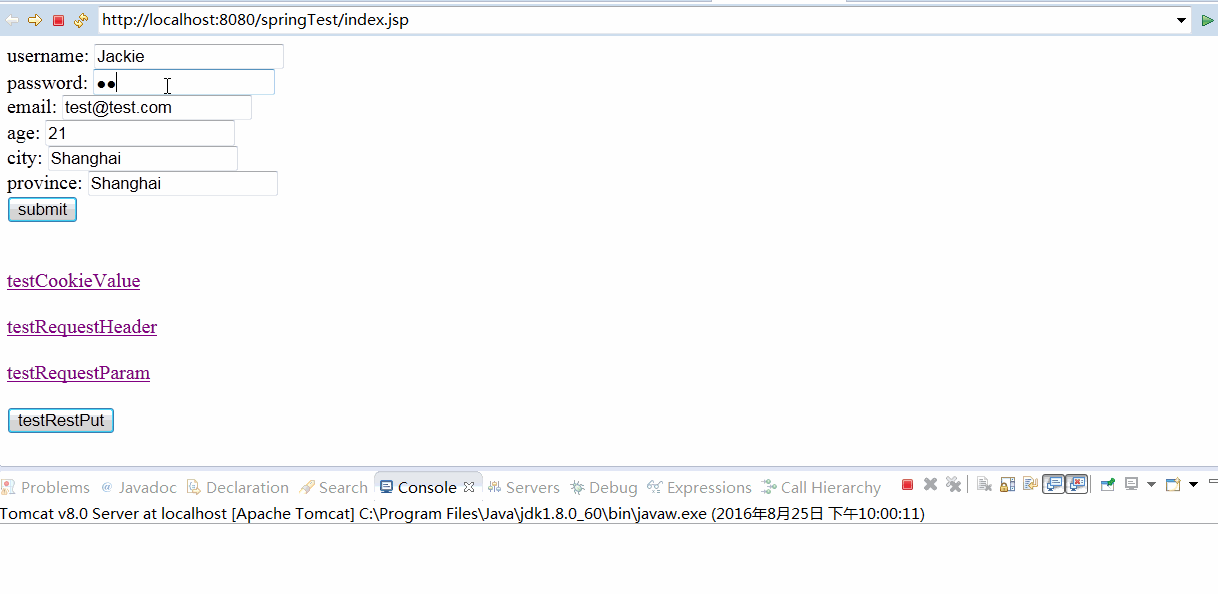各位前排的,后排的,都不要走,咱趁热打铁,就这一股劲我们今天来说说spring mvc的视图解析器(不要抢,都有位子~~~)
相信大家在昨天那篇如何获取请求参数篇中都已经领略到了spring mvc注解的魅力和套路了。搭上@RequestMapping的便车,我们可以去到我们想去的地方(方法)去,借助@RequestParam、@PathVariable等我们可以得到请求中想要的参数值,最终还能够通过神奇的“return SUCCESS”到达我们的目的地。今天主要就来说说在达到目的地的路上,我们都经历了些什么!
在此之前
我们顺便说说@RequestHeader、请求参数类型为POJO(也就是Java对象类型)的情况以及ModelAndView
1. @RequestHeader
这个无需多说,还是原来的配方,还是一样的套路,只要举个例子,你就都明白了。
在SpringMVCTest中添加测试方法
@RequestMapping(value="/testRequestHeader")
public String testRequestHeader(@RequestHeader(value="Accept-Language") String language){
System.out.println("testRequestHeader Accept-Languge:" + language);
return SUCCESS;
}
我们知道一个请求如get请求或post都有请求头和响应头,这里我们想获取的是请求头中“Accept-Language”的具体信息,所以就用上了@RequestHeader注解来获取。
index.jsp中
<a href="springmvc/testRequestHeader">testRequestHeader</a><br/><br/>
启动服务器,点击超链接,我们得到了
testRequestHeader Accept-Languge:zh-CN
2. 请求参数为POJO
前面两篇,我们看到的请求类型都是一些字符串也就是某一个字段。那么如果现在有一个form表单,说夸张点,表单中有10个字段需要提交,行吧,还用原来的匹配的方式,你要用10个参数来接收,累不累?累!有没有办法?有!我们可以把这些要提交的字段封装在一个对象中,从而请求类型就是一个POJO。
这里我们新建一个类User
package com.jackie.springmvc.entities;
public class User {
private Integer id;
private String username;
private String password;
private String email;
private int age;
private Address address;
public Integer getId() {
return id;
}
public void setId(Integer id) {
this.id = id;
}
public String getUsername() {
return username;
}
public void setUsername(String username) {
this.username = username;
}
public String getPassword() {
return password;
}
public void setPassword(String password) {
this.password = password;
}
public String getEmail() {
return email;
}
public void setEmail(String email) {
this.email = email;
}
public int getAge() {
return age;
}
public void setAge(int age) {
this.age = age;
}
public Address getAddress() {
return address;
}
public void setAddress(Address address) {
this.address = address;
}
public User(String username, String password, String email, int age) {
super();
this.username = username;
this.password = password;
this.email = email;
this.age = age;
}
public User(Integer id, String username, String password, String email, int age) {
super();
this.id = id;
this.username = username;
this.password = password;
this.email = email;
this.age = age;
}
@Override
public String toString() {
return "User [id=" + id + ", username=" + username + ", password=" + password + ", email=" + email + ", age="
+ age + "]";
}
public User() {
}
}
还有一个Address类
package com.jackie.springmvc.entities;
public class Address {
private String province;
private String city;
public String getProvince() {
return province;
}
public void setProvince(String province) {
this.province = province;
}
public String getCity() {
return city;
}
public void setCity(String city) {
this.city = city;
}
@Override
public String toString() {
return "Address [province=" + province + ", city=" + city + "]";
}
}
同时我们还需要在SpringMVCTest中写一个testPojo的测试方法
@RequestMapping(value="/testPojo")
public String testPojo(User user){
System.out.println("testPojo: " + user);
return SUCCESS;
}
好了,这样,我们就可以在前台jsp页面上构造这样的表单数据了
<form action="springmvc/testPojo" method="post"> username: <input type="text" name="username"><br> password: <input type="password" name="password"><br> email: <input type="text" name="email"><br> age: <input type="text" name="age"><br> city: <input type="text" name="address.city"><br> province: <input type="text" name="address.province"><br> <input type="submit" value="submit"> </form><br/><br/>
至此,我们启动tomcat服务器,就可以发送一个POJO类型的参数了,并且我们成功了读取了这个请求参数

3. ModelAndView
ModelAndView是什么鬼?其实它是我们经常写在SpringMVCTest里测试方法的返回值类型,在方法体内我们可以通过ModelAndView对象来是像请求域中添加模型数据的,抽象?那就看例子吧~~~
SpringMVCTest中添加方法
@RequestMapping(value="/testModelAndView")
public ModelAndView testModelAndView(){
String viewname = SUCCESS;
ModelAndView modelAndView = new ModelAndView(viewname);
modelAndView.addObject("time", new Date());
return modelAndView;
}
index.jsp中还是添加一个超链接
<a href="springmvc/testModelAndView">testModelAndView</a><br/><br/>
注意我们需要在结果页面中拿到这个放入请求域中的键值对,所以在success.jsp页面中添加
time: ${requestScope.time}<br><br>
最终的效果图是这样的

没错,我们将当前时间信息写进了请求域,并通过视图展示出来。
有了前面的小铺垫,现在我们来唠唠这视图解析器的事儿
视图解析器
这里主要通过调试源代码看看spring mvc的handler是如何利用视图解析器找到并返回实际的物理视图的,别眨眼
1. 如何看源码
说到调试源码,我们就要有源码才行,那么如何看源码,相信这个页面大家已经看腻了吧

没错,这是因为你没有导入源码的jar包,程序没办法给你呈现源代码,还好,这个问题难不倒我们,在第一篇中我们有关于springframework所需要的功能jar包,javadoc以及源码包,那么来导入一波

选中前面提示的spring-context的source jar包,我们就可以一睹这个java文件的庐山真面目了

484很开心~~~
2. 代码调试
为此我们写一个测试方法
@RequestMapping("/testViewAndViewResolver")
public String testViewAndViewResolver(){
System.out.println("testViewAndViewResolver");
return SUCCESS;
}
index.jsp加个链接
<a href="springmvc/testViewAndViewResolver">testViewAndViewResolver</a><br/><br/>
给testViewAndView方法体一个断点,我们进入调试状态,

程序停在断点处,在调试的上下文中,我们找到DispatcherServlet.doDispaatch方法,以此为入口,来看看视图解析器
(1) 进入DispatcherServlet.doDispaatch
定位到
mv = ha.handle(processedRequest, response, mappedHandler.getHandler());

可以看到这里有个mv对象,实际上就是ModelAndView,通过调试我们发现这里的mv中包括了model和view,view的指向就是success,而model这里之所以有值是因为在SpringMVCTest中有一个getUser方法,且加上了@ModelAttribute注解,从而初始化了model。
(2)执行processDispatchResult方法
在doDispatch中继续执行,直到
processDispatchResult(processedRequest, response, mappedHandler, mv, dispatchException);
进入该方法进行视图渲染
private void processDispatchResult(HttpServletRequest request, HttpServletResponse response,
HandlerExecutionChain mappedHandler, ModelAndView mv, Exception exception) throws Exception {
boolean errorView = false;
if (exception != null) {
if (exception instanceof ModelAndViewDefiningException) {
logger.debug("ModelAndViewDefiningException encountered", exception);
mv = ((ModelAndViewDefiningException) exception).getModelAndView();
}
else {
Object handler = (mappedHandler != null ? mappedHandler.getHandler() : null);
mv = processHandlerException(request, response, handler, exception);
errorView = (mv != null);
}
}
// Did the handler return a view to render?
if (mv != null && !mv.wasCleared()) {
render(mv, request, response);
if (errorView) {
WebUtils.clearErrorRequestAttributes(request);
}
}
else {
if (logger.isDebugEnabled()) {
logger.debug("Null ModelAndView returned to DispatcherServlet with name '" + getServletName() +
"': assuming HandlerAdapter completed request handling");
}
}
if (WebAsyncUtils.getAsyncManager(request).isConcurrentHandlingStarted()) {
// Concurrent handling started during a forward
return;
}
if (mappedHandler != null) {
mappedHandler.triggerAfterCompletion(request, response, null);
}
}
这里我们着重看下render方法,然后得到视图的名字,即运行到view = resolveViewName(mv.getViewName(), mv.getModelInternal(), locale, request);进入到该方法后,我们可以看到整个方法如下:
protected View resolveViewName(String viewName, Map<String, Object> model, Locale locale,
HttpServletRequest request) throws Exception {
for (ViewResolver viewResolver : this.viewResolvers) {
View view = viewResolver.resolveViewName(viewName, locale);
if (view != null) {
return view;
}
}
return null;
}
这里用到了视图解析器即this.viewResolvers。而真正的渲染视图在DispatcherServlet的view.render(mv.getModelInternal(), request, response);点击进入这里的render方法,我们选择AbstractView这个抽象类中的该方法
/**
* Prepares the view given the specified model, merging it with static
* attributes and a RequestContext attribute, if necessary.
* Delegates to renderMergedOutputModel for the actual rendering.
* @see #renderMergedOutputModel
*/
@Override
public void render(Map<String, ?> model, HttpServletRequest request, HttpServletResponse response) throws Exception {
if (logger.isTraceEnabled()) {
logger.trace("Rendering view with name '" + this.beanName + "' with model " + model +
" and static attributes " + this.staticAttributes);
}
Map<String, Object> mergedModel = createMergedOutputModel(model, request, response);
prepareResponse(request, response);
renderMergedOutputModel(mergedModel, request, response);
}
该方法负责针对具体的Model呈现具体的view,这时候再进入到renderMergedOutputMode的具体实现类
点击后,我们发现对此方法多个类都有实现,那么到底是哪个呢,实际上是InternalResourceView这个类,为什么定位到这个类,笔者是根据之前在springmvc.xml中配置的视图解析器的线索找到的,当时我们配的是InternalResourceViewResolver这个解析器,所以相应的,这里应该是InternalResourceView类,同时通过加断点,更加验证了这一想法~~~
此外在调试DispatcherServlet的resolveViewName方法时,发现,这里的viewResolver正是我们配置的视图解析器InternalResourceViewResolver

同时发现这里返回的view就是/WEB-INF/views/success.jsp

至此,我们就完成了ModelAndView的逻辑路径向这里"/WEB-INF/views/success.jsp"的物理路径的转化,大致了了解了视图解析器的工作机制(感觉还是没有说清楚--!)。
好了,本篇我们主要学习了
- @Request的用法
- 请求参数为POJO的用法
- ModelAndView的用法
- 如何看源代码
- spring mvc如何通过视图解析器得到真正的物理视图页面
如果您觉得阅读本文对您有帮助,请点一下“推荐”按钮,您的“推荐”将是我最大的写作动力!如果您想持续关注我的文章,请扫描二维码,关注JackieZheng的微信公众号,我会将我的文章推送给您,并和您一起分享我日常阅读过的优质文章。(点赞不迷路,博主带你上高速~~~)